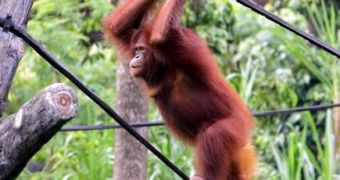A crucial trait that differentiates humans from apes is bipedalism (walking on two feet).
There is a vivid debate on the emergence of bipedalism, as a characteristic feature that set us apart from apes.
A new research on Sumatran orangutans in Gunung Leuser National Park (Indonesia) pushes this trait further than imagined, back to the times when our ancestors were still roaming the trees, before descending to the ground.
Orangutans live almost exclusively on the trees' canopy. On sturdier branches these apes walk on all four limbs, but on lighter branches in search of fruit, the apes advance on two legs while employing their arms for balance.
"When they are on the very fine stuff, they are using bipedalism. It shows that bipedalism can be adaptive in the trees.
People have suspected that it evolved in the trees, but no one has been able to see a sensible reason why it should happen." said co-author Robin Crompton of the University of Liverpool in England. This shows that human ancestors evolved to upright bipedalism as an adaptation to forage for ripe fruit in the trees' peripheries and adds to the many theories explaining the evolution of the bipedalism.
"One of the key realizations of the last century was that during our evolution, walking upright preceded having a big brain," said Paul O'Higgins, an anthropologist at the University of York in England, not involved in this research.
"Ever since then people have been wondering what types of behaviors predisposed walking on two legs."
Common conception said that human ancestors developed bipedalism recently after leaving the forest to inhabit on the African savanna, starting from an all-fours gait (the knuckle walk), still retained by gorillas and chimps.
"The study pushes bipedalism further back into the Miocene [a period that lasted between 24 to 5 million years ago] and up into the trees," said O'Higgins.
"It tells us something about how primates other than ourselves use bipedalism. That could tell us something about how bipedalism might have been used by our distant ancestors. But it doesn't tell us what actually happened. It doesn't show us the origins of our own human bipedalism." said Brian Richmond, a biological anthropologist at George Washington University in Washington, D.C., not involved in the study.
Recent fossil discoveries have pushed back the earliest time when the bipedal human ancestor lived, to some 6 million years ago, while humans split from chimps 4 million years ago.
"Our closest living relatives are chimps and gorillas, and since both of them climb trees and walk on their knuckles, it's most likely that our common ancestor with them did that too," insisted Richmond.
"If our common ancestor with chimpanzees was not a knuckle walker, it means that chimps had to evolve knuckle walking independently from gorillas. But if the new study is correct that bipedalism occurred in very ancient apes, fossil evidence for the trait might no longer be considered a smoking gun that identifies fossils as belonging to a human ancestor. It's going to make it very much more difficult to tell what's a hominid and what's not," he added.

 14 DAY TRIAL //
14 DAY TRIAL //